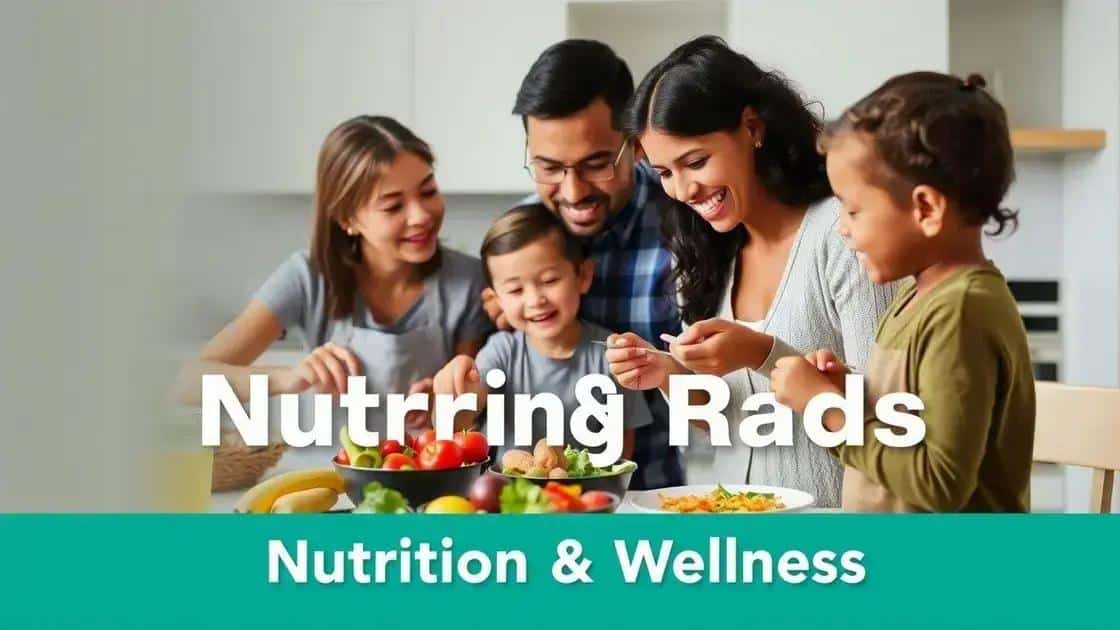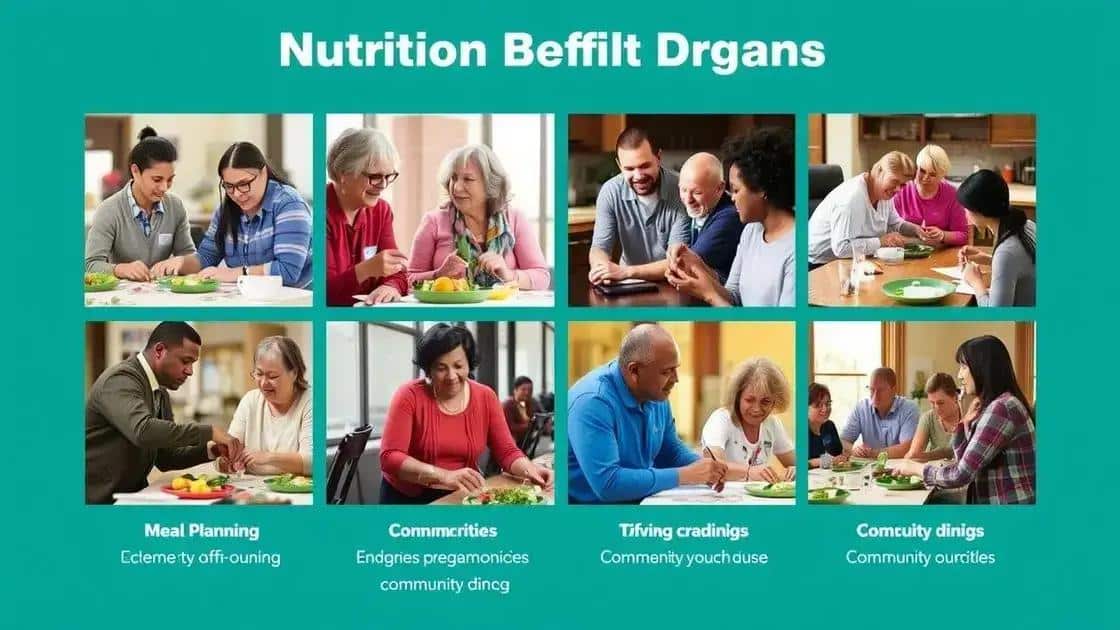Insights on nutrition benefit programs: unlocking benefits

Nutrition benefit programs improve food access for low-income families, providing essential support through financial assistance and education, leading to better health outcomes and reduced chronic diseases.
Insights on nutrition benefit programs can be a game changer for individuals seeking to improve their access to healthy food. With so many options available, it’s important to know how these programs can truly support your well-being.
Understanding nutrition benefit programs
Understanding nutrition benefit programs is essential for maximizing their potential to assist families in need. These programs aim to improve food access for those who qualify, offering vital resources to combat food insecurity.
What Are Nutrition Benefit Programs?
Nutrition benefit programs provide financial assistance, allowing eligible participants to purchase healthy food. These programs are designed to ensure that individuals have access to the necessary nutrients for a healthy life. They typically include programs like the Supplemental Nutrition Assistance Program (SNAP), Women, Infants, and Children (WIC), and others.
Key Features of Nutrition Benefit Programs
- Eligibility Criteria: Most programs have specific requirements based on income, household size, and other factors to determine eligibility.
- Types of Benefits: Participants can receive funds on an electronic benefits card, vouchers, or direct food assistance.
- Nutrition Education: Many programs include education components that teach recipients about healthy eating and cooking.
Aside from financial aid, these programs often focus on enhancing knowledge about nutrition. For example, WIC emphasizes education for mothers on feeding their children healthy foods. This approach not only provides direct assistance but also empowers families with the information they need to make better choices.
Accessing these benefits is typically straightforward. Applicants can visit local government offices or websites to start the process. Many states now offer online applications, making it easier for families to seek the help they need.
The Impact of Nutrition Benefit Programs
Nutrition benefit programs have a significant impact on public health. By aiding in food security, they contribute to healthier populations. Studies show that families who participate in these programs experience improved nutritional intake and overall better health outcomes.
In conclusion, understanding nutrition benefit programs opens the door to essential support for many families. These programs not only provide financial assistance but also promote better health through education and access to nutritious food.
Types of nutrition benefit programs available

Types of nutrition benefit programs available cater to various needs, providing important resources for individuals and families. Understanding these programs helps maximize their potential benefits.
Supplemental Nutrition Assistance Program (SNAP)
The Supplemental Nutrition Assistance Program, commonly known as SNAP, is one of the largest assistance programs in the United States. It provides monthly benefits that help low-income households purchase food. Eligible individuals receive an electronic benefits card, which they can use like cash at grocery stores.
Women, Infants, and Children (WIC)
WIC is another crucial program aimed at supporting the nutritional health of pregnant women, new mothers, and young children. It provides vouchers for specific foods, alongside nutrition education and breastfeeding support. This program helps ensure that mothers and their children receive the nutrients they need during crucial developmental stages.
School Breakfast and Lunch Program
The School Breakfast and Lunch Program provides free or reduced-price meals to students in schools, helping to ensure that children have access to healthy food during the school day. These programs work towards improving educational outcomes by addressing hunger and promoting better concentration in class.
Senior Nutrition Program
This program focuses on older adults, providing nutritious meals through senior centers or home delivery services. It is designed to cater to the dietary needs of seniors, ensuring they stay healthy and receive essential nutrients. Many programs also offer social interaction opportunities through communal dining.
Understanding these types of nutrition benefit programs available allows families to find the assistance that fits their needs. By accessing these resources, individuals can improve their diet and overall health.
Many states also have additional programs that cater to specific community needs, such as local food banks or health initiatives, ensuring that healthy food is accessible to everyone.
Impact of nutrition programs on public health
The impact of nutrition programs on public health is significant and far-reaching. By ensuring access to healthy food, these programs contribute to improved health outcomes in communities.
Improved Nutritional Health
Nutrition programs play a crucial role in enhancing the nutritional intake of individuals, especially those from low-income families. Through initiatives like SNAP and WIC, families gain access to fresh fruits, vegetables, and whole grains, which lead to better overall nutritional health. These programs not only assist families in meeting their dietary needs but also educate them on healthy eating.
Reduction in Chronic Diseases
By providing access to nutritious foods, these programs help reduce the prevalence of chronic diseases such as obesity, diabetes, and heart disease. A better diet can lower risk factors associated with these conditions, ultimately resulting in lower healthcare costs for society.
Positive Economic Impact
Nutrition programs also have a positive economic impact. When families have access to healthy foods, they are likely to spend less on healthcare over time due to improved health. Additionally, programs like SNAP boost local economies by allowing grocery stores and farmers markets to thrive and expand.
Educational Benefits
- Increased Attendance: Children who have access to healthy meals perform better in school and attend more regularly.
- Better Focus: Proper nutrition leads to improved concentration and overall cognitive function.
- Long-term Success: Healthy eating habits established in childhood can lead to better health in adulthood, creating a healthier future generation.
Moreover, nutrition programs foster community engagement and promote social well-being. By bringing people together around food, these initiatives create a sense of belonging and support. Understanding the impact of nutrition programs on public health highlights the importance of these resources in building healthier communities.
How to apply for nutrition benefits

Applying for nutrition benefits can seem overwhelming, but it is a straightforward process. Knowing the steps can help make it easier for individuals and families to access essential assistance.
Gather Necessary Information
Before starting your application, gather important documents such as identification, proof of income, and household information. This may include:
- Identification: Driver’s license or state ID.
- Income Verification: Pay stubs or tax returns.
- Household Information: Names and ages of all household members.
Online Application
Many states offer online applications for nutrition benefits. Visit your local state government’s website to find the online portal. Make sure to fill out the form completely and accurately. If you encounter issues, help is often available through online support or local offices.
In-Person Application
If you prefer a personal touch, you can apply in person at your local government office. Bring your gathered documents and be prepared to answer questions about your household and income. Staff members are available to assist you throughout the process.
Phone Application
Some states also allow applications over the phone. Call the appropriate number provided on your state’s nutrition assistance website. Be ready to provide the same information as you would for an in-person application.
Once submitted, your application will be reviewed. Depending on the program, you may receive a card or vouchers to use for purchasing food. It’s essential to keep track of important dates related to your application and any follow-up steps required.
Understanding how to apply for nutrition benefits can empower families to access crucial resources. Don’t hesitate to reach out for assistance if needed, as support services are often available to guide you through the application process.
FAQ – Frequently Asked Questions about Nutrition Benefit Programs
What are nutrition benefit programs?
Nutrition benefit programs provide financial assistance to help individuals and families access healthy food, improving their nutritional intake.
Who is eligible for these programs?
Eligibility varies by program, but generally, low-income individuals and families, pregnant women, and children may qualify for nutrition benefits.
How can I apply for nutrition benefits?
You can apply online, in person at local government offices, or over the phone. Make sure to have your necessary documents ready.
What types of nutrition benefit programs are available?
Programs like SNAP, WIC, School Breakfast and Lunch Program, and Senior Nutrition Programs are widely available to assist with food access.






